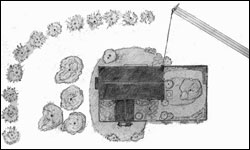Water Smart Landscaping (also known as Xeriscaping™) allows us to utilize water both efficiently and wisely. El Paso receives approximately 8 inches of precipitation per year. The high summer heat and low humidity make it necessary to irrigate our landscape plantings. Currently almost half the water used by residents is used for landscaping.
Our landscapes do not have to be devoid of trees and other plants to be water smart. Indeed to the contrary, the absence of trees in the landscape can result in higher water and utility costs because of the extra cooling necessary to maintain a comfortable living environment. With the following seven principles, trees can provide a comfortable environment with minimal additional water use.
Planning & Design
Planning and design may be the most important step in developing or renovating your landscape. By analyzing your site and making an appropriate design, trees can perform a variety of functions. Smaller trees can be used for screening and larger trees for shade and protection. Deciduous trees (trees which shed their leaves in the winter) should be placed to provide shade from the afternoon summer sun while letting the winter sun provide heat. An especially important consideration is the mature size of a tree. Make sure that the tree is placed where it has space to grow and mature. This helps avoid future maintenance problems such as severe pruning of large trees located under power lines.
Appropriate Turf Areas
 In landscaping, it’s important to consider the needs of both your turf and trees. Avoid planting deciduous trees in an evergreen turf area which needs year-round irrigation. And don’t put an evergreen tree in a winter dormant turf which usually receives water only in the summer. These situations can result in either over—or under watering of the tree. In most areas of El Paso, trees and shrubs should be separated from the turf areas and turf should be limited to areas that are functional rather than decorative.
In landscaping, it’s important to consider the needs of both your turf and trees. Avoid planting deciduous trees in an evergreen turf area which needs year-round irrigation. And don’t put an evergreen tree in a winter dormant turf which usually receives water only in the summer. These situations can result in either over—or under watering of the tree. In most areas of El Paso, trees and shrubs should be separated from the turf areas and turf should be limited to areas that are functional rather than decorative.
Efficient Irrigation
A well planned irrigation design can significantly reduce water use. Placing trees in areas that receive water run-off can provide most of the water an established, drought-tolerant tree needs. An ideal irrigation design has trees in separate irrigation zones from the shrubs and flowers. Irrigation zones should be designed so that plants with similar water use requirements are grouped together. One example would be to place evergreen trees and deciduous trees on separate irrigation zones. This allows you to provide additional winter watering for the evergreen trees without over watering deciduous trees.
Soil Improvements
The most current tree planting research indicates that altering or correcting the existing soil provides no benefit and may actually be detrimental. Appropriate plant selection will alleviate many of the growth problems associated with soil conditions. For instance, do not plant a tree that requires good drainage in heavy clay soils.
Mulches
Mulches can be organic (bark chips, or wood grindings) or inorganic (rock, gravel, or chat). Mulches cover the soil and decrease evaporation, reduce weed growth, slow soil erosion, and provide landscape interest. Neutral colored mulches are preferable to either dark or light colored mulches. Dark mulches increase the upper root zone temperatures dramatically while light colored mulches cause excessive reflected light. Both of these conditions are harmful to trees, especially during the establishment phase.
Use of Trees With Low Water Requirements
There are many low water use trees available for a variety of landscape functions. Some trees provide shade and texture, others act as screens and a few provide seasonal color. Ideally, established low water use trees will need only occasional supplemental water to perform their function for your landscape.
Planning & Maintenance
Many maintenance problems can be avoided at planting. The right tree for the right location will minimize future problems. This means choosing trees appropriate for your soil and avoiding trees that have pest problems or that cannot easily adapt to our weather conditions. And finally, after you have planted your trees, follow the cultivating practices described in the other sections of this tree guide.
Trees & Powerlines

YES!
Right

NO!
Wrong
Trees help to conserve energy if properly placed. To help both you and the utility company avoid problems, never plant large or medium size trees under or near power lines. Know the mature size of the tree you’re planting. Only shrubs or small trees which grow no taller than 20 feet may be planted in the zone directly under utility lines or within 15 feet either side of the power lines.
